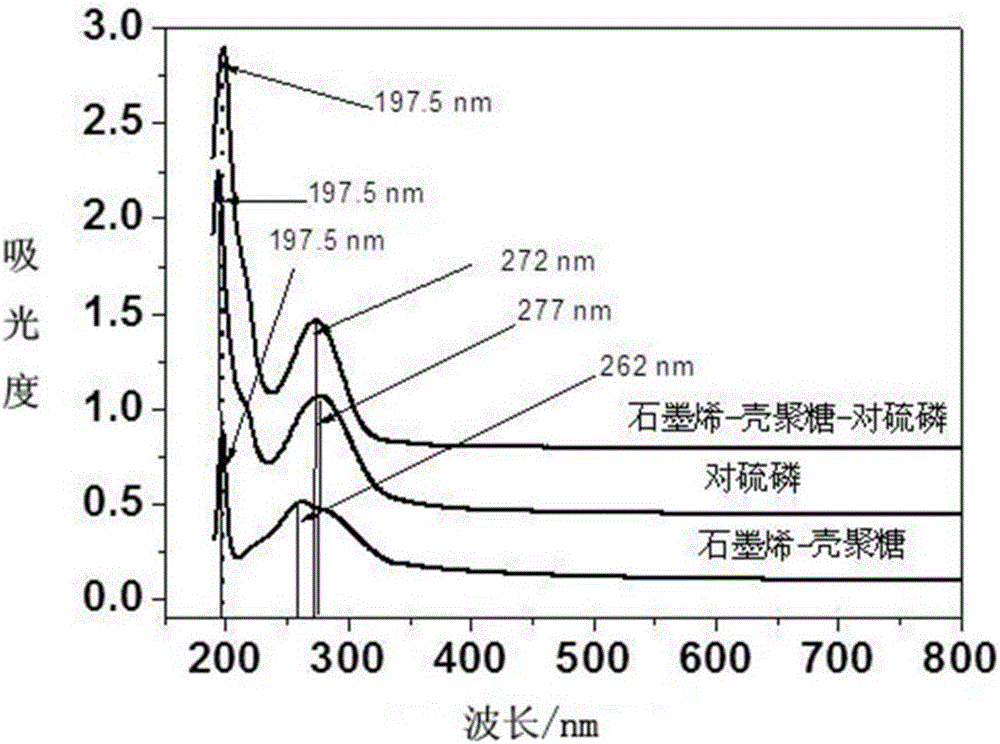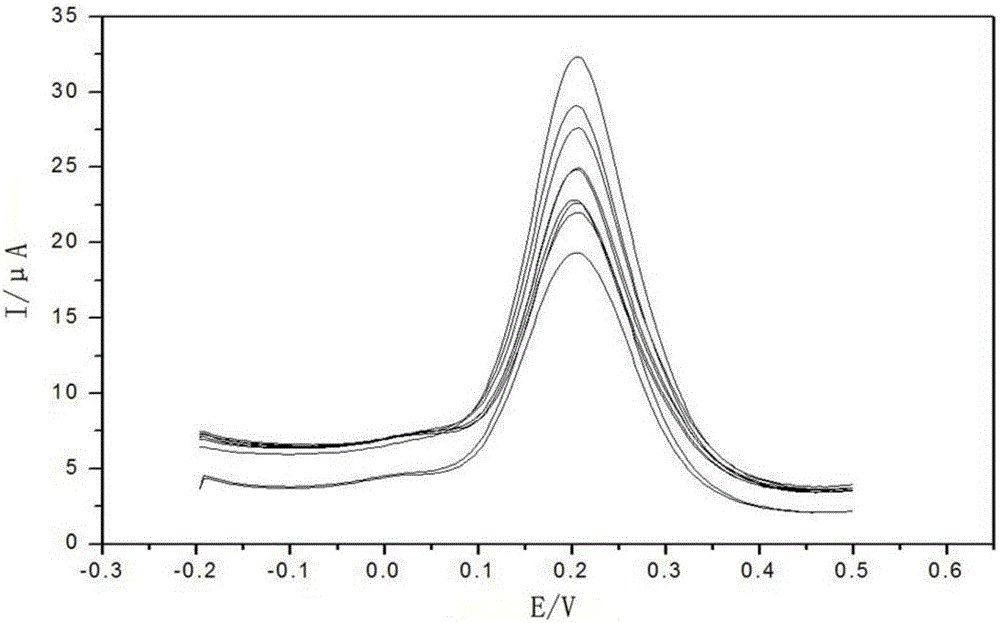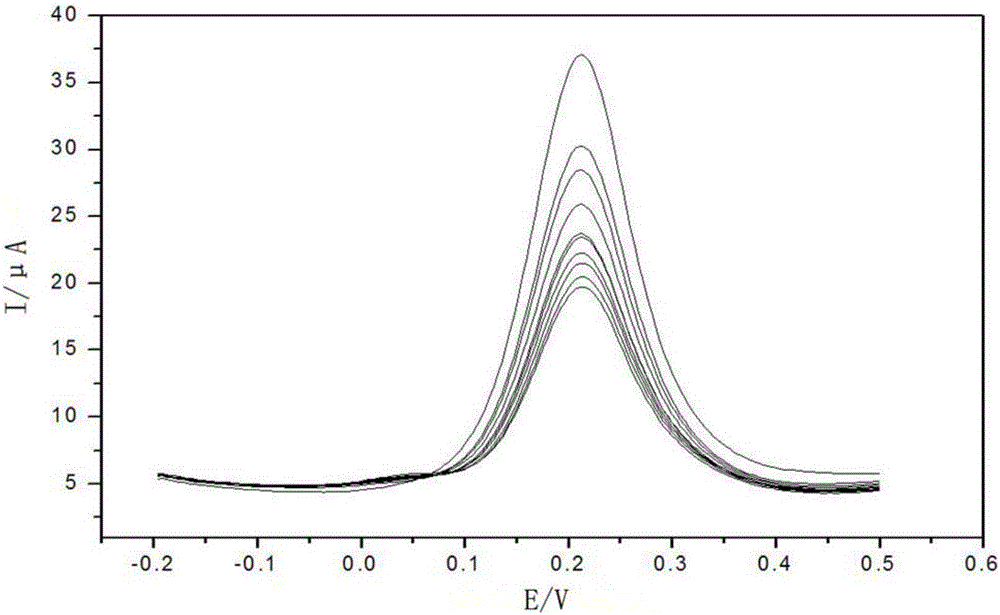Electrochemical detection method of organophosphorus pesticide
An organophosphorus pesticide and detection method technology, applied in the field of food safety detection and analytical chemistry, can solve the problems of cumbersome process operation, differences in catalytic selectivity and catalytic activity, inability to realize on-site detection, etc., to avoid poor repeatability and save detection time. Effect
- Summary
- Abstract
- Description
- Claims
- Application Information
AI Technical Summary
Problems solved by technology
Method used
Image
Examples
Embodiment 1
[0033] Example 1 Preparation of an electrochemical sensor for the detection of organophosphorus pesticides
[0034] (1) Preparation of graphene‐chitosan‐parathion complex
[0035] Graphene (10mg) is added in 4mL chitosan solution (mass concentration is 1g / L), at room temperature ultrasonic dispersion 30min (rotating speed is 5000rpm), then add 2ml parathion solution (mass concentration is 0.2g / L) , continue to sonicate for 30 min, and store in a refrigerator at 4°C until use.
[0036] The UV-Vis absorption spectra of graphene‐chitosan‐parathion composites are as follows: figure 1 shown. The maximum absorption peak of graphene-chitosan dispersion is 262nm, the maximum absorption peak of parathion is 272nm, and the maximum absorption peak of graphene-chitosan-parathion composite is 267nm, located in graphene-chitosan sugar and parathion, indicating that a graphene-chitosan-parathion complex has been formed.
[0037] (2) Preparation of electrochemical sensor: the glassy carbo...
Embodiment 2
[0039] The detection of embodiment 2 organophosphorus pesticide standard samples
[0040] In this example, standard samples of organophosphorus pesticides are detected respectively. , fenthion and trichlorfon.
[0041]The electrochemical sensors prepared in Example 1 were respectively immersed in organophosphorus pesticides with concentrations of 0ng / mL, 1ng / mL, 10ng / mL, 50ng / mL, 100ng / mL, 200ng / mL, 400ng / mL, 600ng / mL, Incubate in 800ng / mL, 1200ng / mL and 1500ng / mL incubation solutions (all of which contain AchE at a concentration of 10μg / mL), rinse with phosphate buffer solution, and in K 3 [Fe(CN) 6 Carry out differential pulse voltammetry (DPV) scan in the solution, record response current; The response current of blank standard sample is I 0 , the response current of the standard sample containing organophosphorus is I x , the increasing value ΔI of the response current is equal to I x with I 0 The difference of the difference; the ΔI and the concentration C of organi...
Embodiment 3
[0048] The standard addition detection of chlorpyrifos in embodiment 3 apples
[0049] Weigh the cleaned apple samples (three parallel samples, each with a mass of 50±0.005g) into a beaker, add chlorpyrifos standard solution, then add 50mL water and 100mL acetone, grind and extract with a chopper for 3min. After filtration, take 100 mL of filtrate and place it in a separatory funnel, add 15 g of sodium chloride, shake vigorously for 3 minutes and then let it stand still. After the solution is separated, extract the aqueous phase with 50 mL of dichloromethane, and combine the acetone and dichloromethane extracts. Dry it with anhydrous sodium sulfate to remove the water, concentrate it by rotary evaporation to about 2mL, blow dry the remaining liquid with nitrogen, and finally add 10mL of ethanol-water solution (V:V=1:1), shake until dissolved, and store in low temperature and shade for later use .
[0050] Prepare a blank sample without adding chlorpyrifos according to the abo...
PUM
| Property | Measurement | Unit |
|---|---|---|
| diameter | aaaaa | aaaaa |
Abstract
Description
Claims
Application Information
 Login to View More
Login to View More - R&D
- Intellectual Property
- Life Sciences
- Materials
- Tech Scout
- Unparalleled Data Quality
- Higher Quality Content
- 60% Fewer Hallucinations
Browse by: Latest US Patents, China's latest patents, Technical Efficacy Thesaurus, Application Domain, Technology Topic, Popular Technical Reports.
© 2025 PatSnap. All rights reserved.Legal|Privacy policy|Modern Slavery Act Transparency Statement|Sitemap|About US| Contact US: help@patsnap.com



